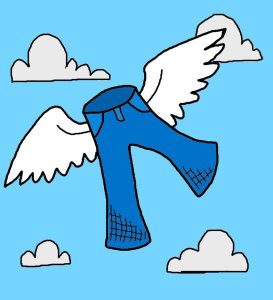
These flying pants are NOT the secret to writing great copy.
This morning I was on the phone with an A-list copywriter whose name you’d recognize…
We were talking about the next project we’re working on together, for his company.
And specifically planning out the campaign and copy angle we’re going to use for an upcoming promotion.
We talked through a few ideas.
And by the end of the call, we had a clear next step: I was going to come up with an outline of what the copy needs to be, and a series of questions that need to be answered to fill in the blanks for the narrative arc.
For me, that has become standard operating procedure. I pretty much always outline any long copy before I write it.
But for others who fancy themselves as being more “creative,” I think this is a foreign concept. So I want to speak to it directly.
Pantsers vs. Plotters…
When you ask writers about their writing process, they tend to fall into one of two camps…
— Pantsers “fly by the seat of their pants.” They may have an idea of where they want the story to go, but they don’t take notes or develop an outline beforehand. They just sit down and start writing.
— Plotters “plot it out.” They sit down and plan out what the plot or narrative arc of their writing is going to be. Some go into great detail. Others create the skeleton and wait until they’re in the thick of things before they fill in the details. Either way, they know where they’re headed, and how they plan to get there.
Is there a right way and a wrong way?
I don’t think so. I think a really good writer can be a Pantser, and churn out really compelling prose. Especially with editing.
But I do think it’s easier to write really compelling prose and copy if you’re a Plotter.
Great copy and other persuasive prose walks people through a series of points that together lead to an inescapable conclusion. There are a series of little sales that need to be made to make the ultimate sale. Being planful and intentional about these steps, these micro-sales, simply helps you hit all these points.
Not only that, having a plan often leads to writing much, much faster. With a plan in hand, you can simply go from one point to the next, knowing exactly what your next stop is and what needs to happen between now and then to get there.
The approach I see in most A-list copywriters…
It shouldn’t surprise you then that nearly every A-list copywriter I’ve spoken with about this uses outlines. They’re Plotters. They decide what they’re going to say, and the points they need to make, before they really dive into the writing.
Most tend to feel that there’s too much at stake to leave profitable copy up to pure “creativity.”
Sure, there’s a ton of creativity that still goes into the process. Finding and putting together the idea is creative. Mapping out the narrative is still a creative process. The way you actually express ideas, and the specific copy you write is creative.
But when it comes time to sit down and develop the chain of logic that leads to the prospect making a buying decision, it makes sense to really ensure you’ve got that mapped out.
I’ll tell you this — a personal secret…
Most of my biggest winners, early on, weren’t even based on my own outlines. They were based on this outline from Clayton Makepeace.
I just found a way to map the narrative I was telling and the product I was selling onto what Clayton had already laid out.
I still got credit for the wins. I still got the royalty checks. But my copy was stronger based on the outline Clayton had laid out.
I know a handful of top copywriters today who all got their start in the same way — by following that exact same copy outline.
If you put a gun to my head, here’s what I’d do…
John Carlton is famous for his “gun to the head” exercise (and Halbert before him)…
Imagine that someone is standing there over you while you’re writing this ad, with a gun to your head. If you don’t write a winner, they’re going to pull that trigger.
Given this situation, you’re only going to use what you have the highest confidence is going to lead to a winner — because your life depends on it!
If I’m in that situation, I’m NOT going to sit down and start writing. I’m going to start off by sitting down to outline exactly what I’m going to say, in what order, to have the biggest sales impact. (Actually, not exactly outline. I used to use mind maps, and now I’m a big-time WorkFlowy user.)
It’s only once I’ve developed a really clear, compelling outline of exactly what I’m going to say that I’d then go back and start writing the actual copy.
By knowing exactly what I need to say to make the compelling sales argument, I’m ahead of the game on creating a winner before I really start writing copy.
So, what are you going to do?
Your life may not be on the line with your next campaign, ad, or promotion. But your money is. Either actual investment in advertising, if you’re writing for yourself. Or your reputation and your royalty checks, if you write for clients.
Think carefully about what you’re going to do, and what’s most likely to create that winner.
Yours for bigger breakthroughs,
Roy Furr



